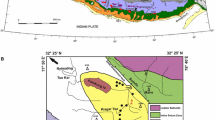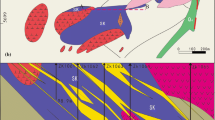Abstract
The Mazraeh Cu–Fe skarn deposit, NW Iran is the result of the intrusion of an Oligocene–Miocene granitic pluton into Cretaceous calcareous rocks. The pluton ranges in composition from monzonite to quartz monzonite, monzogranite, tonalite and granodiorite with I-type, calc-alkaline, and weakly peraluminous characteristics. The Mazraeh pluton was emplaced in a volcanic arc setting in an active continental margin at a depth of ~8 km. Pyroxene skarn, garnet skarn, and epidote skarn zones were formed during the intrusive phase. The garnet skarn developed as exoskarn and endoskarn from the calcareous wall rocks and the pluton, respectively, prior to mineralization. Garnet skarn from the exoskarn zone is identified by relict layering inherited from the precursor calcareous lithologies. Mass balance calculation of garnet skarn in the endoskarn zone indicates that hydrothermal fluids originating from the cooling magma introduced Si, Fe, Mn, Ca, Mg, P, Ag, Cu, Zn, La, Pb, Cd, Mo, and Y. The main mass loss in the garnet skarn was due to destruction of feldspars in the Mazraeh plutonic rocks and leaching of K2O and Na2O. Released Ca has been fixed in the andraditic garnet. Garnetization of the Mazraeh pluton was accompanied by mass and volume increase. The magnitude of these changes depends mainly on the degree of alteration and composition of the precursor. The brittle behavior of the endoskarn zone was increased due to formation of massive garnet which subsequently fractured. These fractures not only facilitated movement of hydrothermal fluids but also provided new locations for Cu mineralization. Therefore locating strongly garnetized zones may be a vector to ore in skarn deposits.










Similar content being viewed by others
References
Babaie HA, Ghazi AM, Babaei A, La Tour TE, Hassanipak AA (2001) Geochemistry of arc volcanic rocks of the Zagros crush zone, Neyriz, Iran. J Asian Earth Sci 19:61–76
Barrett T, MacLean WH (1991) Chemical, mass, and oxygen-isotopic changes during extreme hydrothermal alteration of an Archean rhyolite, Noranda. Econ Geol 86:406–414
Barrett T, MacLean WH (1994) Mass changes in hydrothermal alteration zones associated with VMS deposits of the Noranda area. Explor Min Geol 3:131–160
Barrett T, MacLean WH, Tennant SC (2001) Volcanic sequence and alteration at the Parys Mountain volcanic-hosted massive sulfide deposit, Wales, United Kingdom: application of immobile element lithogeochemsitry. Econ Geol 96:1279–1305
Bazin D, Hubner H (1969) Copper deposits in Iran. Report No. 13, Geological Survey of Iran, pp 1–29
Berberian F, Muir ID, Pankhurst RJ, Berberian M (1982) Late Cretaceous and early Miocene Andean-type plutonic activity in northern Makran and Central Iran. J Geol Soc London 139:605–614
Brunet MF, Cloetingh S (2003) Integrated peri-Tethyan basins studies (peri-Tethys programme). Sediment Geol 156:1–10
Cail TL, Cline JS (2001) Alteration associated with gold deposition at the Getchell Carlin-type gold deposit, north-central Nevada. Econ Geol 96:1343–1359
Darvishzadeh A (1991) Geology of Iran. Neda Publication, Tehran, pp 1–901
De la Roche H, Leterrier J, Grande Claude P, Marchal M (1980) A classification of volcanic and plutonic rocks using R1–R2 diagrams and major element analyses—its relationships and current nomenclature. Chem Geol 29:183–210
Dini A, Rocchib S, Westermanc DS (2004) Reaction microtextures of REE–Y–Th–U accessory minerals in the Monte Capanne pluton (Elba Island, Italy): a possible indicator of hybridization processes. Lithos 78:101–118
Droop GTR (1987) A general equation for estimating Fe3+ concentrations in ferromagnesian silicates and oxides from microprobe analyses, using stoichiometric criteria. Mineral Mag 51:431–435
Eftekharnejad J (1975) Brief history and structural development of Azarbaijan. Geological Survey of Iran, Internal Report, pp 1–8
Goodfellow WD, Peter JM (1993) Geochemistry of hydrothermal altered sediment, Middle Valley, Northern Juan de Fuca Ridge. In: Devis E et al (eds) Proceedings of ocean drilling program, scientific results, Leg 139, College Station
Grant JA (1986) The isocon diagram—a simple solution to Gresens’ equation for metasomatic alteration. Econ Geol 81:1976–1982
Jenner GA (1996) Trace element geochemistry of igneous rocks: geochemical nomenclature and analytical geochemistry. In: Wyman, DA (ed) Trace element geochemistry of volcanic rocks: applications for massive sulfide exploration, Geological Association of Canada, Short Course Notes 12:51–77
Karimzadeh Somarin A (2004a) Geochemical effects of endoskarn formation in the Mazraeh Cu-Fe skarn deposit in northwestern Iran. Geochem Explor Environ Anal 4:307–315
Karimzadeh Somarin A (2004b) Garnet composition as an indicator of Cu mineralization: evidence from skarn deposits of NW Iran. J Geochem Explor 81:47–57
Karimzadeh Somarin A (2005) Petrology and geochemistry of Early Tertiary volcanism of the Mendejin area, Iran, and implications for magma genesis and tectonomagmatic setting. Geodin Acta 18:343–362
Karimzadeh Somarin A (2006) Geology and geochemistry of the Mendejin plutonic rocks, Mianeh, Iran. J Asian Earth Sci 27:819–834
Karimzadeh Somarin A, Ashley P (2004) Hydrothermal alteration and mineralization of the Glen Eden Mo-W-Sn deposit: a leucogranite-related hydrothermal system, Southern New England Orogen, NSW, Australia. Miner Deposita 39:282–300
Karimzadeh Somarin A, Moayyed M (2002) Granite- and gabbrodiorite-associated skarn deposits of NW Iran. Ore Geol Rev 20:127–138
Karimzadeh Somarin A, Lentz DR (2008) Mineralogy, geochemistry and fluid evolution of a fossil hydrothermal system in the Paleogene Mendejin volcanic sequence, East Azarbaijan, Iran. Mineral Petrol 94:123–143
Kuscu I (2001) Geochemistry and mineralogy of the skarns in the Celebi district, Kirikkale, Turkey. Turk J Earth Sci 10:121–132
Kwak TAP, Askins PW (1981) Geology and genesis of the F-Sn-W(-Be-Zn) skarn (wrigglite) at Moina, Tasmania. Econ Geol 76:439–467
Le Maitre RW (1989) A classification of igneous rocks and glossary of terms: recommendations of the International Union of Geological Sciences Subcommission on the systematics of igneous rocks. Blackwell, Oxford, pp 1–193
Leitch CHB, Lentz DR (1994) The Gresens approach to mass balance constraints of alteration systems: methods, pitfalls, examples. In: Lentz D (ed) Alteration and alteration processes associated with ore-forming systems. Geological Association of Canada, Short course notes, vol 11, pp 166–192
Lentz DR (2005) Mass-balance analysis of mineralized skarn systems: implications for replacement processes, carbonate mobility, and permeability evolution. SGA 2005, mineral deposit research, meeting the global challenge, Beijing, vol 1, pp 421–424
Lentz DR, Walker J, Stirling J (1995) Millstream Cu-Fe skarn deposit: an example of a Cu mineralised magnetite-rich skarn system in northern New Brunswick. Explor Min Geol 4:15–31
MacLean WH (1990) Mass change calculations in altered rock series. Miner Deposita 25:44–49
MacLean WH, Hoy LD (1990) Geochemistry of hydrothermally altered rocks at the Horne mine, Noranda, Quebec. Econ Geol 86:506–528
Maniar PD, Piccoli PM (1989) Tectonic discrimination of granitoids. Geol Soc Am Bull 101:635–643
Meinert LD (1992) Skarns and skarn deposits. Geosci Can 19:145–162
Meinert LD, Dipple GM, Nicolescu S (2005) World skarn deposits. In: Hedenquist JW, Thompson JFH, Goldfarb RJ, Richards JP (eds) Economic geology 100th anniversary volume. Society of Economic Geologists, Littleton, pp 299–336
Moazzen M, Modjarrad M (2005) Contact metamorphism and crystal size distribution studies in the Shivar aureole, NW Iran. Geol J 40:499–517
Mohajjel M, Fergusson CL (2000) Dextral transpression in Late Cretaceous continental collision, Sanandaj-Sirjan zone, western Iran. J Struct Geol 22:1125–1139
Mollai H (1993) Petrochemistry and genesis of the granodiorite and associated iron-copper skarn deposit of Mazraeh, Ahar, East Azarbaijan, Iran. Unpublished PhD thesis, University of Roorkee, Roorkee, pp 1–265
Newberry RJ, Burns LE, Swanson SE, Smith TE (1990) Comparative petrologic evolution of the Sn and W granites of the Fairbanks-Circle area, interior Alaska. In: Stein HJ, Hannah JL (eds) Ore-bearing granite systems; petrogenesis and mineralizing processes. Geol Soc Am, Special Paper 246:121–142
Pearce JA, Harris NBW, Tindle AJ (1984) Trace element discrimination diagrams for the tectonic interpretation of granitic rocks. J Petrol 25:956–983
Seward TM, Barnes HL (1997) Metal transport by hydrothermal ore fluids. In: Barnes HL (ed) Geochemistry of hydrothermal ore deposits. Wiley, New York, pp 435–486
Shahabpour J (1999) The role of deep structures in the distribution of some major ore deposits in Iran, NE of the Zagros thrust zone. J Geodyn 28:237–250
Spear FS, Cheney JT (1989) A petrogenetic grid for pelitic schists in the system SiO2–Al2O3–FeO–MgO–K2O–H2O. Contrib Mineral Petrol 101:149–164
Vander Auwera J, Verkaeren J (1993) Occurrence of contrasting skarn formations in dolomites of the Traversella deposit (Ivrea, Italy). Geol Rundsch 82:726–740
Wilson AD (1955) Determination of ferrous iron in rocks and minerals. Bull Geol Surv G B 9:56–58
Zemann J, Wedepohl KH (1972) Copper. In: Wedepohl KH (ed) Handbook of Geochemistry. Springer, Berlin, p 29
Acknowledgments
This contribution is based on field and laboratory studies carried out at the University of Tabriz, Iran. Funding for this project was provided by Research Office at the University of Tabriz and I wish to acknowledge the generous support from all staff of this office. The manuscript benefited greatly from critical reviews by P. Ashley, P. Sengupta, and I. Braun.
Author information
Authors and Affiliations
Corresponding author
Rights and permissions
About this article
Cite this article
Karimzadeh Somarin, A. Garnetization as a ground preparation process for copper mineralization: evidence from the Mazraeh skarn deposit, Iran. Int J Earth Sci (Geol Rundsch) 99, 343–356 (2010). https://doi.org/10.1007/s00531-008-0394-0
Received:
Accepted:
Published:
Issue Date:
DOI: https://doi.org/10.1007/s00531-008-0394-0




